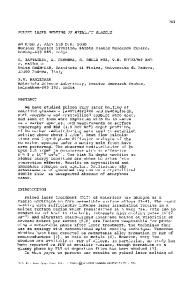Controlled Crystallization of Metallic Glasses Through Joule Heating
- PDF / 179,300 Bytes
- 12 Pages / 612 x 792 pts (letter) Page_size
- 15 Downloads / 362 Views
Controlled Crystallization of Metallic Glasses Through Joule Heating Marcelo Knobel1, Rafael Piccin1, Fábio C.S. da Silva1, Walter J. Botta Filho2, Alain Reza Yavari3 1 Inst. de Física Gleb Wataghin, Univ. Estadual de Campinas (UNICAMP), Campinas, SP, Brazil. 2 Depto. de Engenharia de Materiais, Universidade Federal de São Carlos (UFSCar), SP, Brazil. 3 LTPCM-CNRS, Inst. Nat. Polytechnique de Grenoble, Grenoble, France.
ABSTRACT This work reviews the basic aspects of an alternative thermal treatment of metallic glasses by Joule heating, which explores the heat produced by an electrical current flowing through samples. The advantages of this annealing method are discussed, and a brief description of available models in a variety of materials is given. The experimental procedures are discussed in detail, with emphasis in a new variant of Joule heating, known as "linear varying current Joule heating". This method allows one to precisely monitor the structural transformations that take place during annealing, by interrupting the thermal treatment at any desired point, leading to samples with controlled micro and/or nanostructures. Some examples of Joule heating curves in novel bulk amorphous samples are shown, to illustrate the excellent perspectives of this annealing technique.
INTRODUCTION It is well known that suitable thermal treatments can improve and stabilize the physical properties of amorphous materials produced by rapid solidification techniques. The soft magnetic properties of ferromagnetic amorphous materials (both ribbons and wires) are further improved either by low-temperature anneals which induce structural relaxation or by high temperature thermal treatments, leading to surface crystallization [1] and/or nanocrystallization [2,3]. Besides an enhancement of the magnetic properties, fast-heating treatments can lead to materials with better mechanical properties [4]. In particular, techniques that explore the heat released by an electrical current flowing through the sample (Joule heating) have emerged as one of the most promising methods to obtain materials with optimized physical properties. Joule heating is conceptually simple and experimentally versatile, allowing one to follow the structural transformation of the samples through on-line monitoring the materials resistance during annealing [5]. This rapid annealing technique was introduced as an alternative in metallic glasses by Jagielinsky [6], who used a fixed applied current pulse for a short time, and therefore named the technique as “flash annealing”. For longer thermal treatments (using weaker current intensities), the technique was called “current annealing” [7], or simply, “Joule heating” [5,8,9].One of the major advantages of Joule heating is that after annealing the materials display improved magnetic properties when compared to samples annealed using conventional furnaces [4,10]. More recently, Joule heating has been used to induce specific anisotropies in amorphous ribbons L5.3.1
and wires to obtain higher giant magnetoimpedance ratios
Data Loading...











